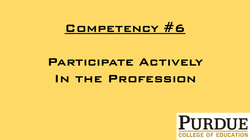
- Identifies and participates in communities of practice within the field of Educational Technology.
Return to RB Purdue LDT Portfolio Homepage
Artifacts: EDCI 672 Malcolm Gibson Case Study Analysis Fall 2016
EDCI 513 Mechanix Paper Summer 2016
Narrative:
I have selected two artifacts as evidence. The first is a paper documenting my work with the Texas A&M Computer Science department regarding their online tutorial called Mechanix. This is a tool that greatly benefits my PLTW Principles of Engineering students. I produced this paper in my first Purdue LDT course in the Fall of 2015 and later presented the paper at CPTTE 2016 (Convention on Pen and Touch Technology in Education) at Brown University in April 2016. The second artifact is a case study during Fall 2016 that involved an instructional designer contracted to digitize college courses in pursuit of a grant to fund their transition to online courses. This second artifact closely matches my vision of producing rigorous and engaging secondary online courses.
Following is the set-up regarding my work on the Mechanix tool with the Texas A&M Computer Science Sketch Recognition Lab (TAMU SRL). TAMU SRL is an educational organization that I identified as a co-traveler on the journey to a quality and rigorous on-line world and I applied, and was accepted, to participate in this community of practice within the field of Educational Technology.
"Engaging, rigorous, and interactive tutorials are the crux of quality online courses. Though improvement is realized from well-constructed digital lectures versus their in-class counterparts, studies centered around quality practice supports are reflecting opportunities for significant learning.
In a quest to address this important market, the Texas A&M Computer Science Engineering Sketch Recognition Lab (TAMU SRL) has applied their human-computer expertise to the production of Mechanix. Mechanix is an online tutorial tool providing immediate constructive feedback to learners while also providing individual learner metrics to the instructor."
Developing the case for working with various educational communities to identify potential online tutorial opportunities took us to an analysis from Tripp and Bechelmeyer:
"Given the similarities between software engineering and instructional design, especially instructional design for computer-based instruction, rapid prototyping may offer all the same advantages in instructional development that it offers in software development. The argument can be made that rapid prototyping is even more appropriate for instructional design because it allows the flexibility needed when dealing with the greater complexity of a human factors-intensive field such as the process of instruction. (p. 36)"
Online tutorials providing immediate constructive feedback to the student and student-level metrics to the instructor are a viable and critical tool for the next generation of instruction. We need teams comprised of multiple disciplines to create the most effective versions of these tools.
My larger vision is addressed in the second artifact where we encounter a case study where the ID is digitizing instruction. "Online learning is here to stay and the question is not whether one should adopt an online program or not, but how can one produce an online program that reflects the quality of the traditional delivery system?...Numerous reports, surveys, and studies have shown that the eLearning industry is gaining speed with increasing numbers of individuals, corporations, and institutions turning to eLearning as they recognize its effectiveness and its convenience." (Marks, 2016, p. 75)
Here is the challenge that IDs face when digitizing courses for the legacy instructors to deliver:
"One barrier to faculty acceptance of eLearning is the idea of quality. University faculty members question the rigor, authenticity, and value to future employers in eLearning contexts." (Marks, 2016, p. 75)
This is a major challenge, at the secondary level, which I, and myriad others, are addressing.
As further evidence of my professional engagement, following are activities on my calendar for pursuit in 2017.
- This was my third year to present at TCEA (Texas Computer Education Association) continuing on a topic progression of flipped classroom, on-line classroom, and blended/on-line classroom tools.
- I will be supporting my district's vision of creating on-line course offerings of high school courses.
- I will be following up my work with the Texas A&M Computer Science Sketch Recognition Lab (TAMU SRL) on the Mechanix tool, with another on-line tool, Sketchtivity/Coursesketch, that addresses a different key student skill. Both tools are focused on relieving the instructor assessment load while providing immediate constructive feedback to the student based on the tool's intelligent interpretation of the student sketches compared with the task standard.
- I regularly engage in book studies with peers, small groups, and personally.
After 23 years in Telecom, I dove headfirst into the pursuit of quality, engaging and rigorous online courses for secondary programs. As this is a major industry disruption, industry community involvement, be it with visionaries or traditionalists, is key to facilitating progress. The body of work presented here strongly supports my possession of this competency of working within the community at my high school, Texas A&M CS, and various industry specialty forums (PLTW (Project Lead the Way)/TCEA (Texas Computer Education Association)).
Marks, D. B. (2016). Theory to Practice: Quality Instruction in Online Learning Environments.National Teacher Education Journal, 9(2), 75 – 80.
Tripp, Steven D.; Bichelmeyer, Barbara. (1990). Rapid prototyping: an alternative instructional design strategy. Educational Technology Design and Research (ETD&R) Journal, 38(1), 31-43. dx.doi.org/10.1007/bf02298246
